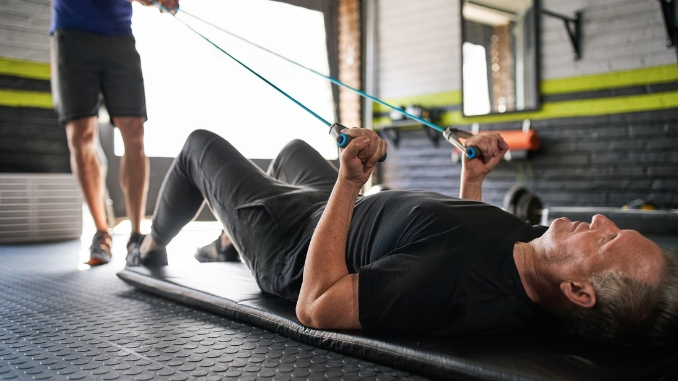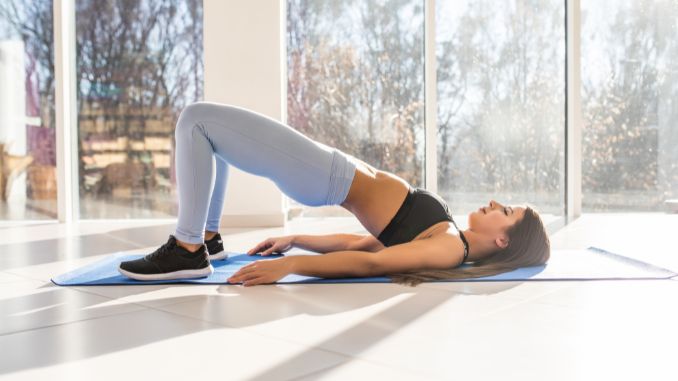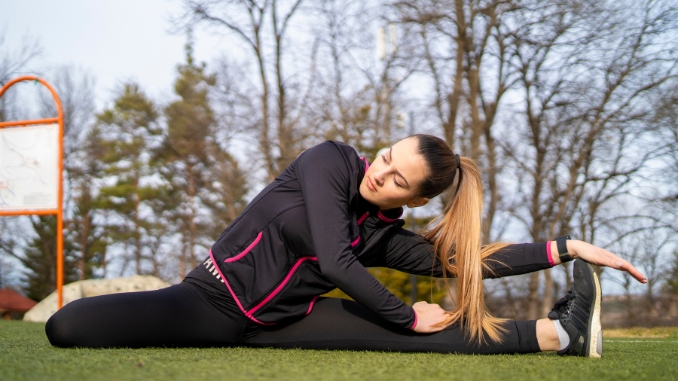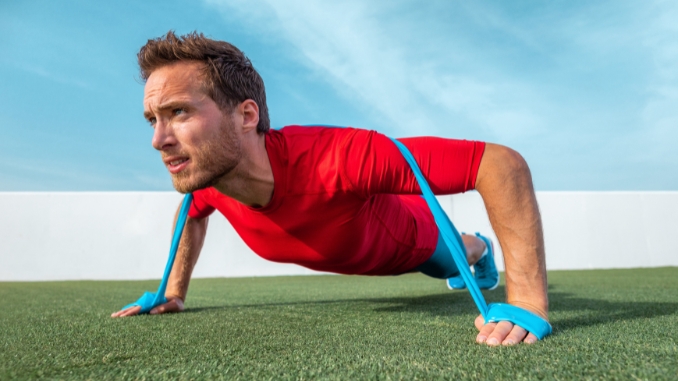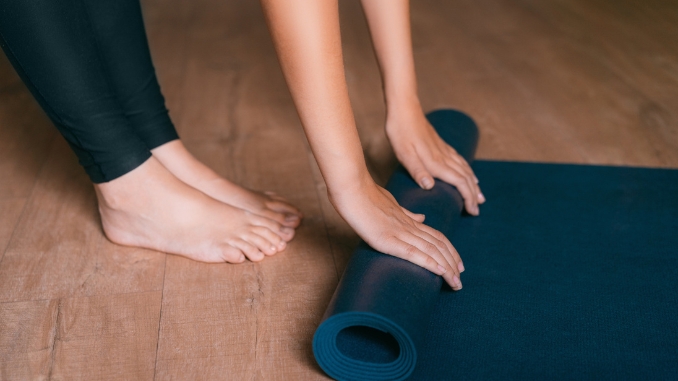If moving around is challenging, don't worry—exercising is still possible! In exploring "How to Exercise with Limited Mobility," we focus on strengthening. It doesn't matter if you're dealing with getting older, getting over an injury, or managing a long-term condition—there are ways to build strength.
We'll look at exercises that can be adjusted for different mobility levels and create personalized routines. This journey isn't just about moving; it's about finding a way for everyone to feel stronger and healthier, no matter the physical challenges. Let's discover simple and effective ways to make exercise work for you!
Understanding Limited Mobility and its Impact on Exercise
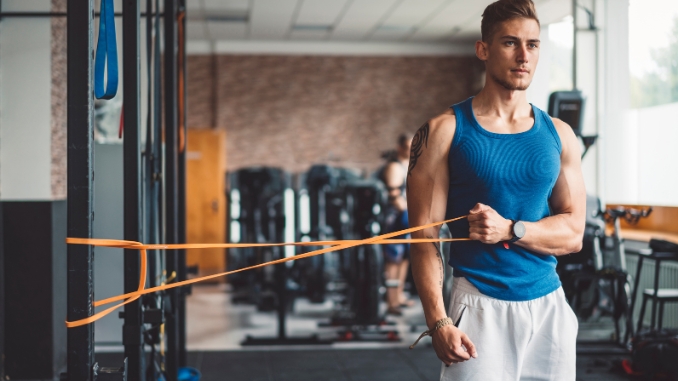
Limited mobility can significantly affect a person's ability to stay active. This is especially crucial for older adults, as staying mobile is critical for independence and daily tasks. Every minute of physical activity may lower risk of heart attack or coronary death in older adults with limited mobility[¹]
Changes in walking, balance, and strength can lead to falls and hinder socializing. Loss of mobility can also increase the risk of diseases, disabilities, and hospitalizations. Research is ongoing to identify factors contributing to physical disability and develop ways to prevent or reverse it.
Home-based programs like CAPABLE, which combines nursing, occupational therapy, and handy worker services, promise to enhance mobility for low-income older adults. Regular exercise is critical for a healthy lifestyle, even for those with limited mobility due to injury or disability.
How Strength Training Can Empower People with Limited Mobility

Strength training is of utmost importance[²] for individuals with limited mobility. Limited mobility can be driven by various factors like chronic diseases, aging, sedentary lifestyle, or disabilities. Engaging in a strength training exercise program can have numerous benefits for individuals with limited or mobility issues.
Cardiovascular exercise also improves cardiovascular health and increases overall endurance. Therefore, incorporating strength training into the exercise routine of individuals with limited mobility enhances their quality of life and promotes overall well-being.
Assessing Your Mobility Limitations and Setting Realistic Goals
For those facing physical limitations, evaluating and setting practical goals is crucial. Understanding your current mobility and potential risk factors is essential for improvement.
Identifying areas needing enhancement, like gait speed or life-space mobility, allows for specific, measurable, attainable, relevant, and time-bound (SMART) goal-setting.
The International Classification of Functioning, Disability and Health (ICF) aid in comprehending goal disparities and enhancing healthcare.
Regular assessments and outcome measures are vital for goal adjustments and tracking progress. By realistically setting and regularly evaluating goals, individuals can proactively work towards improving mobility and overall well-being.
What to Do When You Can't Exercise Due to Injury
Facing an exercise break due to injury can be tough, but maintaining a positive outlook is vital.
Acknowledge the emotional ups and downs and allow yourself to feel various emotions. Shift focus from what's restricted to what's possible, exploring interests like reading or learning a new skill. Mindfulness can fill the void left by physical activity.
If you're seeking personal growth, it's advisable to seek advice from a physical therapist or health professional before resuming exercise, paying close attention to any pain or discomfort signals.
Navigating this challenging time with grace fosters resilience, emphasizing the importance of adapting and finding fulfillment beyond traditional exercise routines.
How to Exercise if You Have Limited Mobility
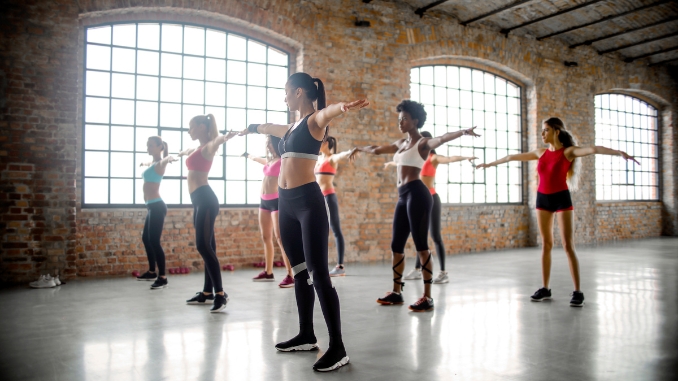
Regular physical activity or exercise is critical for a healthy lifestyle, even for those with limited mobility. Despite challenges, staying active is possible and brings health benefits.
The CDC advises older adults with restricted mobility to aim for 150 minutes of moderate or 75 minutes of intense activity weekly, including strength and balance exercises or even chair yoga poses. Consult a doctor before starting, especially with health conditions or surgeries.
Recommended exercises for limited mobility include water workouts, using groceries for strength, resistance bands, and grip improvement. Warm up, listen to your body, and exercise safely.
With the right mindset and guidance, exercising safely can still be incorporated into their daily life for physical and mental well-being to those with limited mobility. To get started, try something as simple as "arm circles" – gently rotating your arms in a circular motion to improve shoulder mobility and flexibility.
Strength Training Techniques for Individuals with Limited Mobility
Strength training is an important component of an exercise routine, even for individuals with limited mobility. Common examples of strength-training exercises include:
These exercises can help build muscle strength and improve overall fitness levels.
Seated Exercise for Limited Mobility
Discover the benefits of chair exercises with our Seated Exercise for Limited Mobility program. Sitting exercises allow you to stay active and improve your fitness comfortably, making them ideal for individuals with mobility limitations.
For the following exercises, you can use a chair, bench, stability ball, or anything stable that is not too high or low to sit comfortably.
Warm Up
1. Seated Shoulder Roll
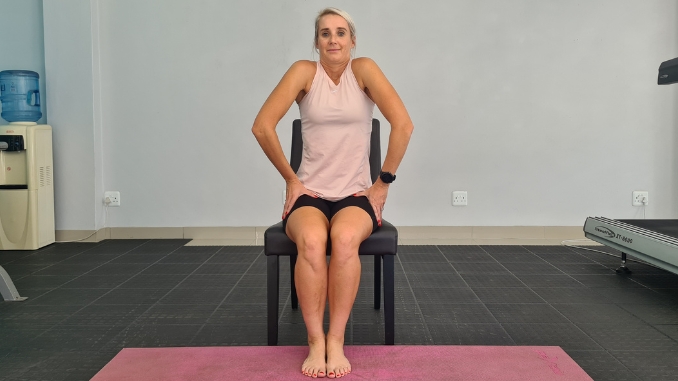
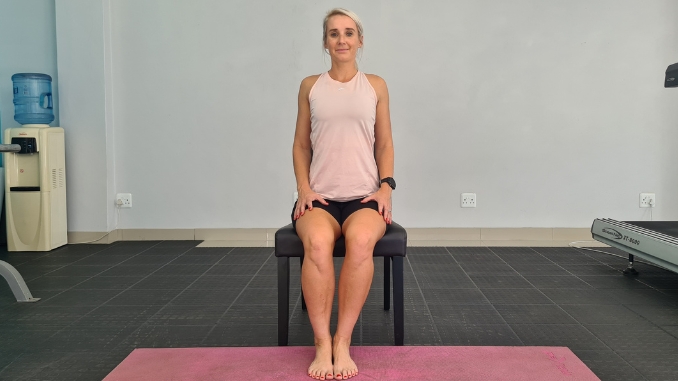
Begin in an upright sitting position with your feet flat on the floor, maintaining a good alignment with your head, shoulder, and hips. Engage your core. Roll your shoulder towards your ears and then roll backward in a circular motion. Complete the movement with 10 repetitions.
2. Seated Arm Raises
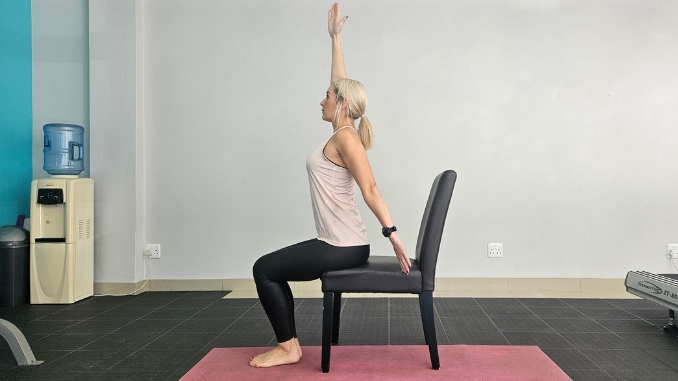
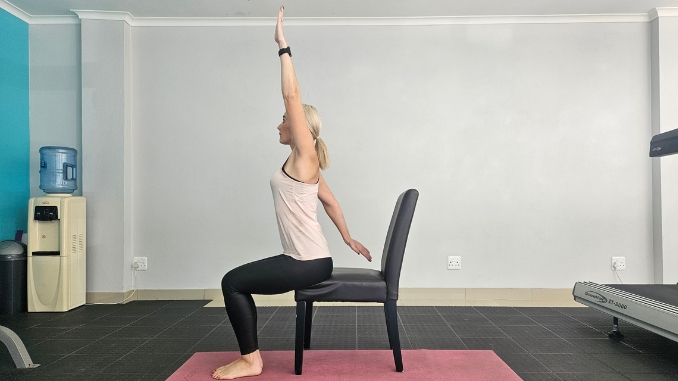
Begin in an upright sitting position with your feet flat on the floor, maintaining a good alignment with your head, shoulders, and hips. Engage your core and raise one hand overhead. Repeat the movement, alternating direction. Complete the movement with 10 repetitions on both hands.
3. Leg Circles
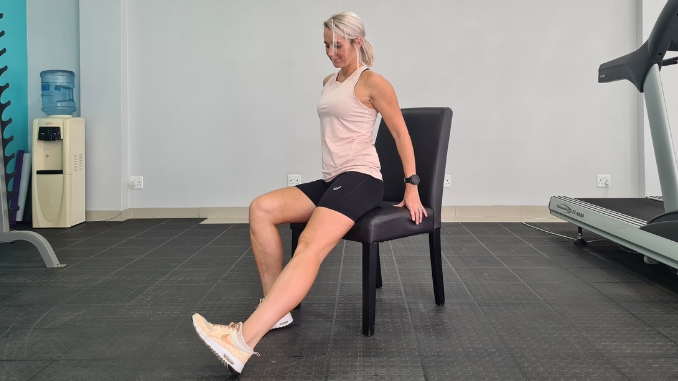
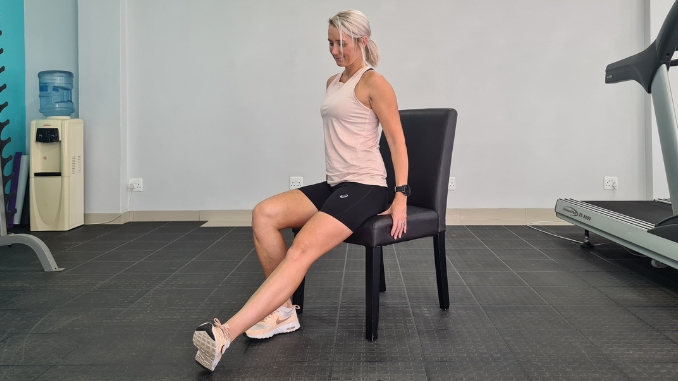
Begin in an upright sitting position with your feet flat on the floor, maintaining a good alignment with your head, shoulders, and hips. Engage your core. Extend one foot forward with your heel planted on the floor, then rotate your leg in a circular motion in both directions. Return to the starting position. Repeat the movement on the opposite leg—complete 10 repetitions.
4. Seated Ankle Circles
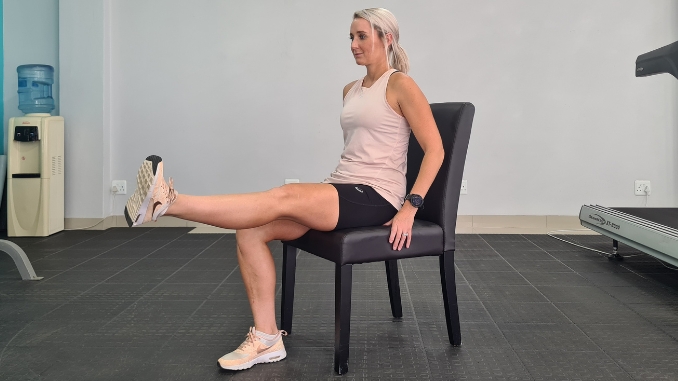
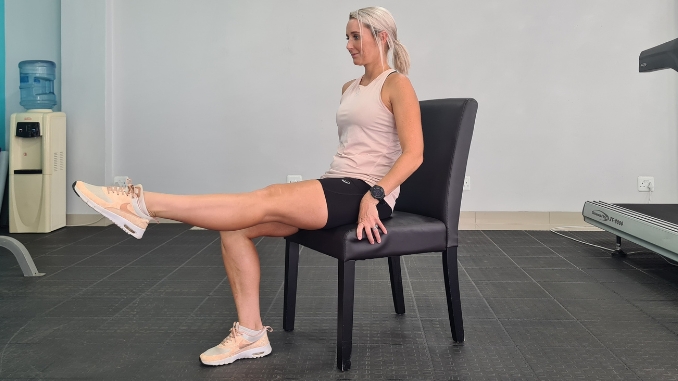
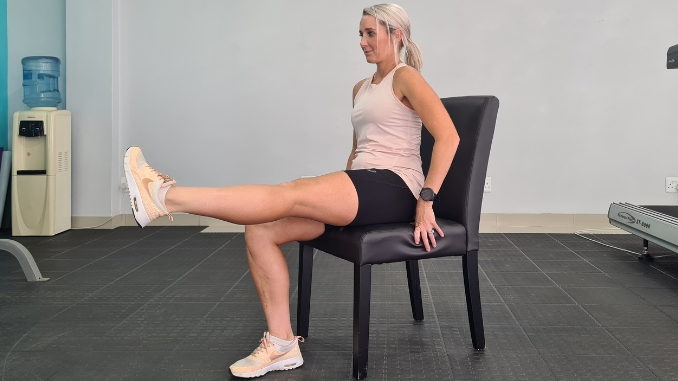
Routine
1. Seated Reach and Pull
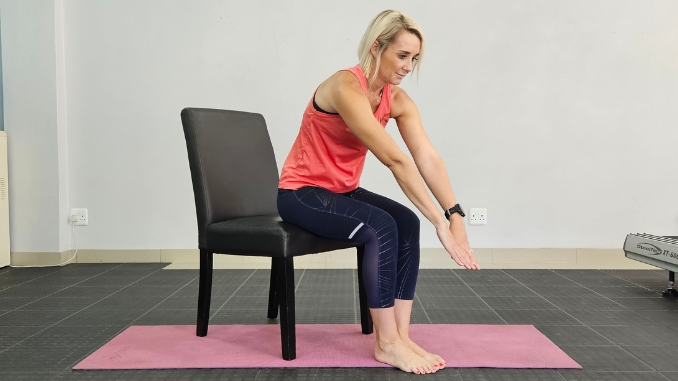
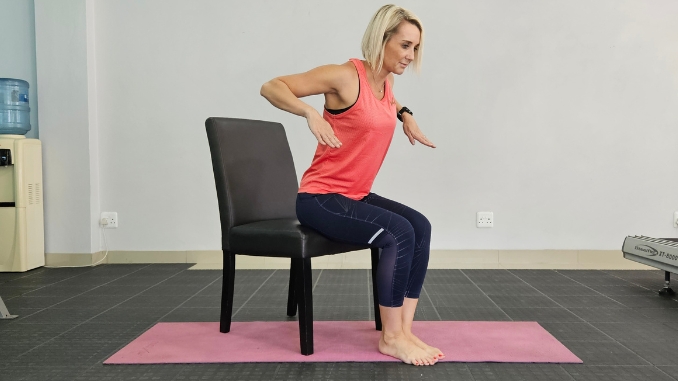
Begin in an upright sitting position with your feet flat on the floor, maintaining good alignment with your head, shoulders, hips, and legs. Engage your core. Hinge through your hips to lean your upper body forward and extend both arms straight in front of your body. Looking for a stretch through the chest and front of the shoulders, pull your arms back, squeezing your shoulder blades together at the end position. Return to the starting position and repeat the movement. Start with 3 sets of 10 repetitions.
2. Seated Knees to Chest
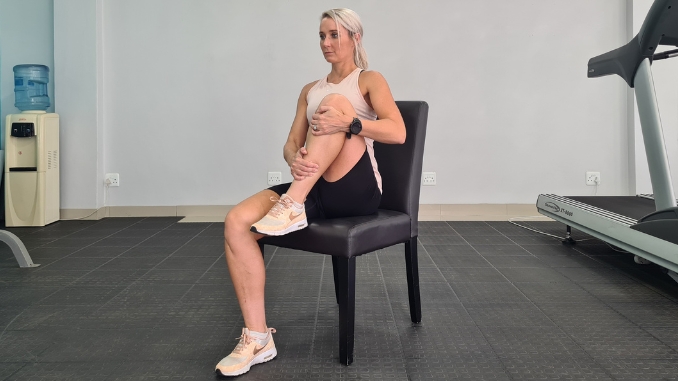
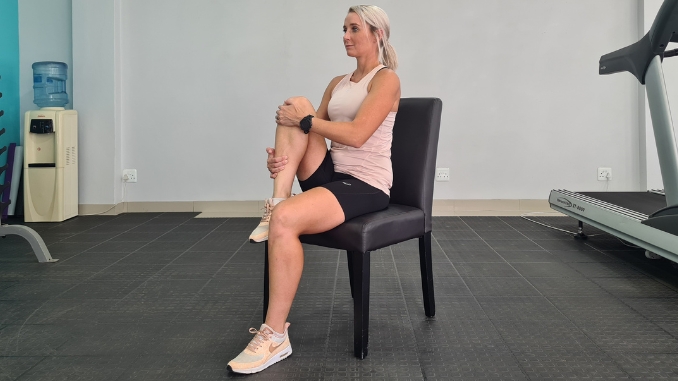
Begin in an upright sitting position with your feet flat on the floor, maintaining good alignment with your head, shoulders, hips, and legs. Engage your core. Bring one knee towards your chest and rest your foot at the edge of the chair, grabbing your leg with both hands. Hold the position for a couple seconds. Return to the starting position and repeat the movement on the opposite side. Start with 3 sets of 10 repetitions on each side.
3. Seated Bent Over Rows
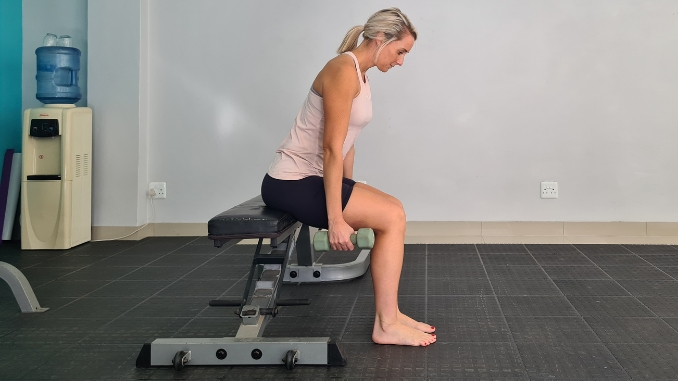
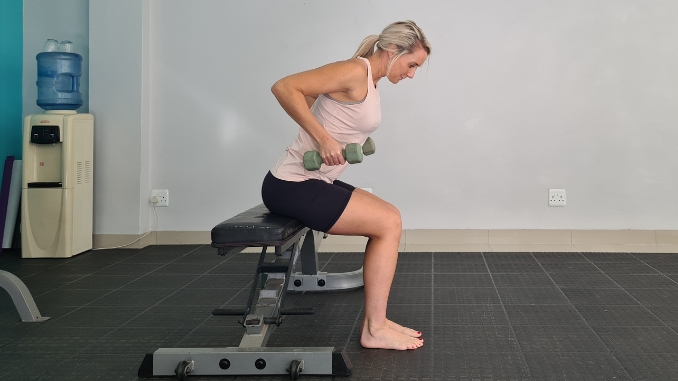
Begin in an upright sitting position with your feet flat on the floor, maintaining a good alignment with your head, shoulders, and hips. Hold a dumbbell in each hand and engage your core. Hinge through your hips to lean your upper body forward, keeping your spine straight, then bring the dumbbell to hip height. Repeat the movements for 10 repetitions.
4. Chair Squat
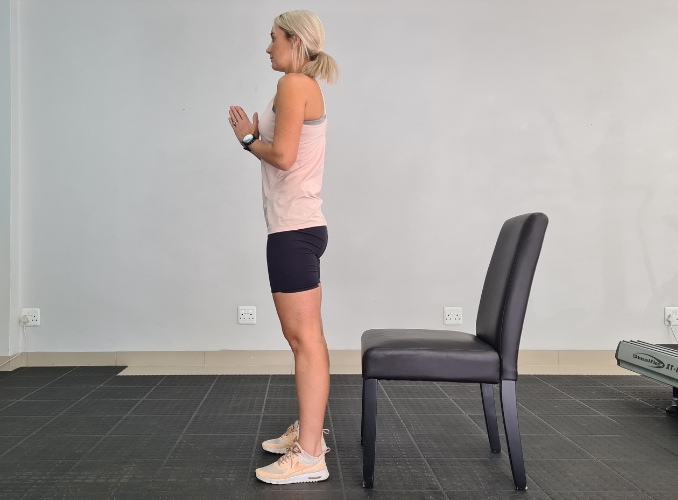
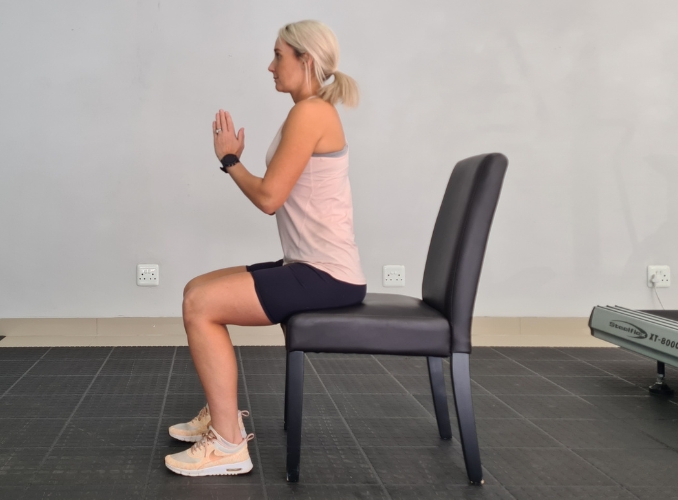
Begin in an upright standing position with your feet hip-width apart, maintaining good alignment with your head, shoulders, hips, and legs. Bring your hands in front of your body at chest height with your palms together. Tighten your abdominal muscles. Bend your knees and hinge through your hips to lower your seat until you tap the chair. Push through your heels to return to the standing position, squeezing your glutes at the top position. Repeat the movement and complete 3 sets of 10 repetitions.
5. Hip Abduction
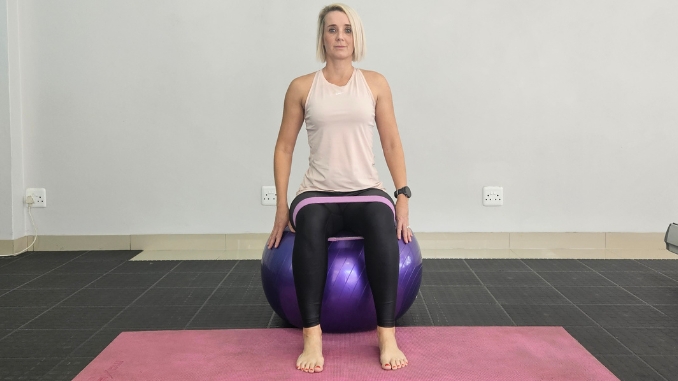
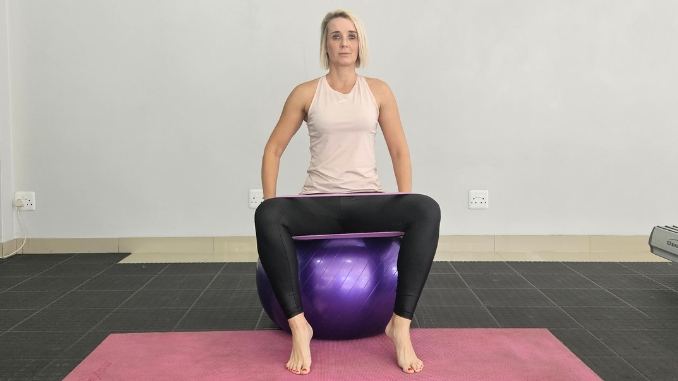
Place one hand on a chair or against a wall for balance if needed for this exercise.
Begin in an upright sitting position on the stability ball with your feet flat on the floor, maintaining good alignment in your upper body. Wrap the mini band around your thighs, just above your knees. Engage your core by pulling your belly button towards your spine, ensuring your back is straight, then pivot from your ankles to open your knees to the sides. Bring your ankles back together to return to the starting position and repeat the movement. Start with 3 sets of 10 repetitions.
If the band is too challenging at this position, move it closer to your hips to reduce the difficulty.
6. Internal Rotation
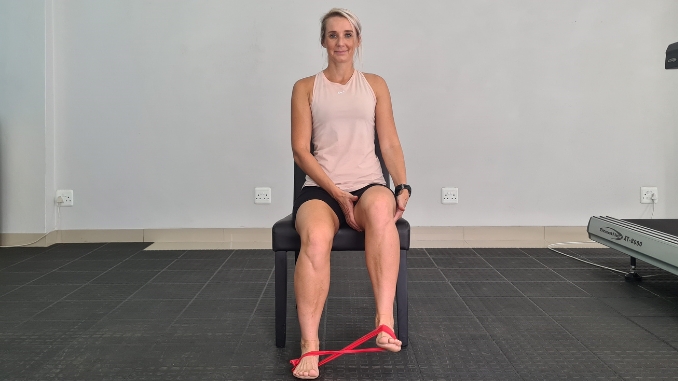
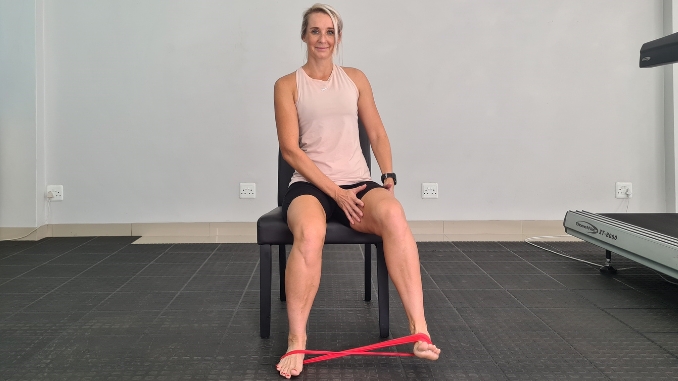
Begin in an upright sitting position with your feet shoulder-width apart, maintaining good alignment with your head, shoulders, hips, and legs. Loop a mini band around both feet and engage your core. With very minimal assistance from your hands, rotate one foot into internal rotation, ideally as far as the tension of the band allows, and keep the other foot planted on the floor. Return to the starting position. Relax and repeat the movement on the opposite foot.
Cool Down
1. Seated Triceps Stretch
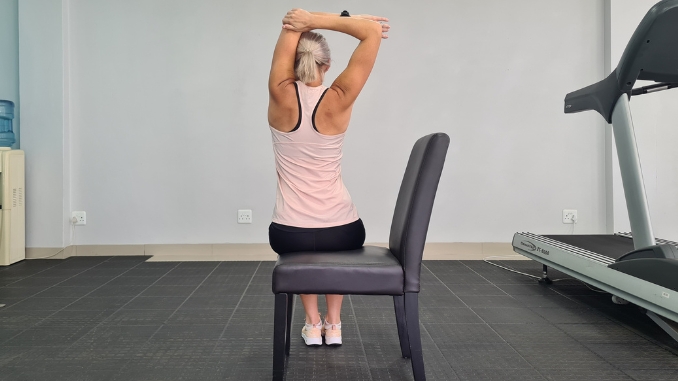
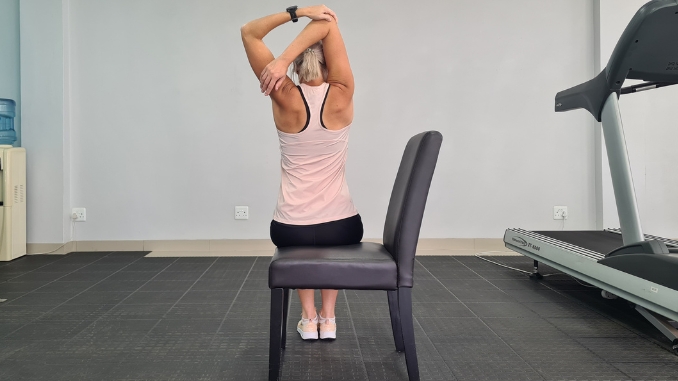
2. Seated Figure 4
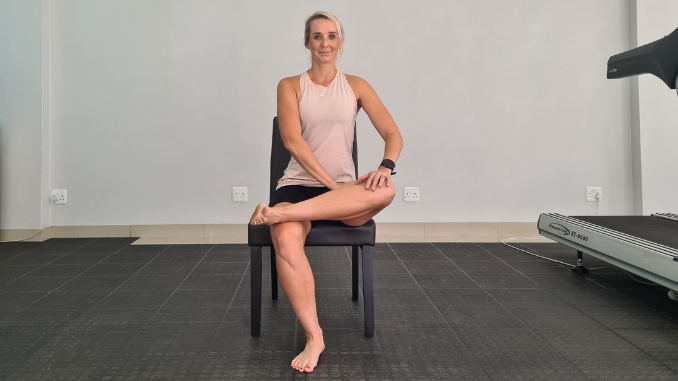
Begin in an upright sitting position with your feet flat on the floor, maintaining good alignment with your head, shoulders, and hips. Cross one ankle over your opposite knee. Engage your core and hinge through your hips to bend your upper body forward. Hold this position for 10 seconds. Return to the starting position. Repeat the movement on the opposite side.
3. Seated Quadriceps Stretch
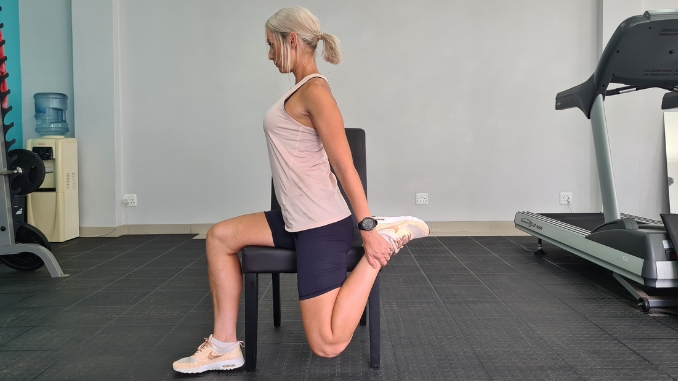
Begin in an upright sitting position with your feet flat on the floor, maintaining good alignment with your head, shoulders, and hips. Shift to one side of the chair, allowing one leg to hang off the side. Engage your core. Bring one heel up behind you and grab the ankle with your hand. Hold this position for 10 seconds. Return to the starting position. Repeat the movement on the opposite side.
Wrap with a towel or strap around your foot and hold the ends to help pull your heel closer.
Incorporating Resistance Bands for Added Challenge
One effective way to add challenge to your workout routine is by incorporating resistance bands and other equipment. Resistance bands are versatile and portable tools that can increase the intensity of various exercises.
They provide constant tension throughout the movement, targeting specific muscles and helping to improve strength and stability. Incorporating resistance bands makes activities such as squats, lunges, and bicep curls more challenging.
Other equipment, such as dumbbells, medicine balls, and kettlebells, can also be used to add resistance and increase the difficulty of your workouts. These tools allow for an excellent range of motion and engage more muscle groups, leading to more significant strength gains and overall fitness improvement.
By incorporating resistance bands and other equipment, you can take your workouts to the next level and achieve your fitness goals more effectively.
Tips for Staying Motivated and Consistent
Staying motivated and consistent with your strength training routine can be challenging, but with the right strategies, it is possible to maintain your dedication and achieve your fitness goals.
Seeking Professional Guidance and Assistance

Seeking professional guidance and assistance can be a wise decision in various aspects of life. Expert guidance can provide valuable insights and expertise in career, personal development, or financial matters.
Professionals have the knowledge and experience to offer advice and support to help individuals make informed decisions and navigate complex situations. Their objective perspective and expertise can shed light on different options and help individuals make the best choices for their circumstances.
Seeking professional guidance and assistance shows a willingness to learn, grow, and improve, which can lead to better results and success in the long run.
Conclusion
Strength training exercises are a potent tool to enhance the well-being of individuals with limited mobility. Despite initial challenges, adjustments can be made to suit various abilities and physical constraints.
Regular strength training empowers individuals to increase muscle strength and improve balance, coordination, and overall physical function. Strength training also exerts a favorable influence on mental and emotional well-being, elevating self-assurance and self-esteem.
Ultimately, individuals with restricted mobility can experience a revitalized sense of empowerment as they seize control of their health and fitness journey by embracing strength training and customizing it to suit their limitations, thus enhancing their mental and emotional health.
Do you want to loosen up tight joints, increase flexibility and improve mobility with safe, low-impact routines that are simple enough for anyone to complete? Check out this Get Moving- 10 Minutes to Greater Mobility now!

